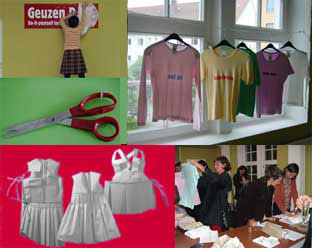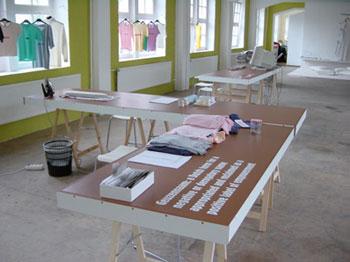In Conversation with De Geuzen
How does open source software relate to paper dolls, dress making, libraries and dinner parties? Lina Dzuverovic-Russell talks to the De Geuzen art collective and discovers how the geek ethos overlaps with the practice of everyday life.
 How did the three of you meet and start working together?
How did the three of you meet and start working together?
We started working together while studying at the Jan van Eyck Akademie in Maastricht. Our collaborations began informally with one of us initiating this or that and the other two joining in. We enjoyed the social process of brainstorming and testing our ideas with each other. At a certain point it was clear our collaborations had become more than a habit, and in 1996, at the same time we moved into our studio in Amsterdam, we became known as De Geuzen.Can you talk about what backgrounds each of you came from?
Femke studied graphic design and is currently involved in design education. Riek has a mixed background of fine art, theatre design and cultural theory. She is also a trained nurse working in the home care service. I (Renee) studied both fine art and cultural theory and am engaged in art education. In terms of our working process, we pool our various skills together but tasks don't breakdown along rigid disciplinary lines. There is a lot of playing in the hybrid zones.
As one of the central themes in your work you examine the notion of public and private. De Geuzen studio practice must be a daily negotiation between public and private spheres. How does this work on a day to day level?
It is interesting that you ask this because recently the function of our studio has shifted. Because we've been travelling much more over the past two years and doing projects in different places, our space has become less important as an actual work place. Although we still use it for public events, in general we've started to take a more ambulant approach. Travelling with our laptops we have learned to adapt and set up shop just about anywhere. We've worked in tiny hotel rooms, corners of cafes, and once even in the furniture section of a department store. When we are not on the road, we often meet in each others homes as well. Actually, its consoling to realise that we don't need a fixed place to work. In a way, the website is our fixed address; as a constant, it's our home away from home. The roles that De Geuzen members assume vary from project to project. The relationship to your audiences must shift dramatically as you assume the role of artist/facilitator/hostess/lab assistant.
 In projects such as the 'Walk in Reader' and 'Instructional Manuals for Popular Use' the visitors to the space drive the interaction which places certain expectations on the visitor.
In projects such as the 'Walk in Reader' and 'Instructional Manuals for Popular Use' the visitors to the space drive the interaction which places certain expectations on the visitor.
Presumably, there must be people who walk into the space expecting to take a passive role. You must get mixed reactions when people realise that with De Geuzen, it's all about being active from the moment you walk into the room. A bit like when you go to see a magician's show and you get picked to assist in the next magic trick and have to walk onto the stage.
Is the ambiguity of these roles ever difficult to communicate to the people who walk into the space?
It seems that you are addressing the issue of interface, meaning how things are visualised to suggest a response or a mode of interaction and exchange with the audience. You're right in saying that we don't have a singular strategy; tactics change according to the specifics of the work itself and the general context. Hitting the right tone is always difficult but nonetheless essential to engage with others.
We really don't have singular strategy ; tactics change depending on the context or specifics of a particular project. For the exhibition at KunstlerHaus Bremen, it was important to make a space that didn't feel too precious but it was comfortable to work in. We set up working stations with simple tables and all the necessary materials were available. There was a computer, a sewing machine, scissors, an iron etc. People were surprisingly comfortable with getting down to business. It took only one person to start making an iron on transfer of their favourite Geuzennaam and then everyone else soon followed. In fact people started combining words and placing them on different places on their own clothing. Those things you can never completely script because it is about the audience making the work their own.
With the Temporary Archive in Manifesta and the Walk-in Reader at De Appel, we made the space for people to linger and research. Both projects lasted for a couple of months which meant there was time to slowly build a relation with the audience and establish 'regulars'. It was surprising when people started adding their own books to our collection because they felt it could expand the area of research. There was something almost viral about the way these collections grew and the space changed as a result. If you think about De Certeau's adage 'space is a practised place', it is only through interaction and for that matter occupation that many of our projects are completed.Your work is often found in 'non-spaces', in areas of galleries and art centres that are normally seen as dead spaces in terms of exhibiting art. (The doormat, the education space, the library).
What have your experiences of inhabiting obscure corners of traditional art spaces been like, both when working with curators and with the public?
These locations are somewhat unassuming, they don't evoke the same kind of expectations and to be honest that's refreshing. Within an art context it is difficult to make something discoverable but these non-spaces allow for that. The doormat is a good example; when people entered the Royal College they simply wiped their feet across 'democracy' and entered the exhibition. It was only when leaving and seeing the official label of the work near the front entrance that people grasped it as a performative act.
When we don't occupy these periphery spaces and work in a central area of an exhibition, the challenge is then how to inhabit the space. If you look at the Walk-in Reader or the project in Bremen we tried to make it feel lived in, almost as if the space had been designed for the purposes of being a workplace or a research/reading room.
You describe your practice as multi-visual research. The research involves everything from curating, event programming to design, web presence and more traditional visual art projects. At this point, do you feel that through the range of experiences you have gone through, you have carved a more defined area for 'multi visual research' in social situations and spaces in relation to when you started?In the beginning, our practice was often driven by intuition and lucky accidents but through time and a continuum project, we are more conscious of our interests and can steer the work. While the accident and intuition still figure in, certain threads have emerged and we develop them through different projects. Take the issue of female representation for example, it is researched through the collaboration with the Rode Draad, the De Geuzen Uniforms, the Geuzen Paper Dolls and various seminars we have hosted in our space. Maybe the long and short of multi-visual research could be summarised as 'there is more than one way to skin a cat'. Over time, we have established this as a methodology and expanded our visual vocabulary as we moved along.
In your series of events entitled the 'Mediated Image', you introduce a format that I have always wanted to ask you more about: a themed dinner. As a format, this strikes me as an ideal mix of the informal and the formal to the extent that I wonder why it doesn't happen more often. But then again, I have never been to a themed dinner, so I'm wondering what this experience was like?Did it border on performance, a set of presentations, or was it more informal? Was the dinner conversation strictly centered on De Certeau, or was it left open?Given the nature of De Certeau's writings and his concern with 'the practice of everyday life', it seemed important to engage with his work in an accessible manner. A meal seemed to be the perfect medium. In spite of the tremendous amount of dishes we had to wash, the experience as a whole really worked. We designed different table clothes with De Certeau quotes, which were revealed as the various courses were served. The speakers sat with the audience and at a certain moment they simply arose and addressed the dinner guests. The experience was like a dinner serenade or an evening of story telling. Also, because we were the waitresses, we had a very intimate relation to our audience.
I am interested how the open source ethos of online environments relates to the socio-informatic open source projects that you work on.
In your work, what is fascinating to me is your desire to give the same level of attention to detail to a set of hyperlinks as you do to a dressmaking pattern, the fact that you even provide a tape measure that people can print out or that you would go as far as to print Michel de Certeau's 'la perruque' strategy on your aprons as you are waitressing during your hosted dinner - it is the desire to make any piece of information truly useful and accessible.
Looking at these projects reminds me of listening to programmers talk about the 'elegance' of code and the importance that is placed on the code and the way in which it is written.
How do you relate to, communicate with and share strategies with online open source communities?We are by no means technically minded, but we do relate to the open source approach. It is really the modern word for sharing and building on various sets of knowledge or experience. The web is thankfully inundated with these kinds of learning communities. Think about the housewife who posts her favourite recipe only to have it prepared and adapted by someone else or home gardners who offers online fertilising tips. Like these people, we are domestic users of the net as opposed to those who understand the mechanics of it. We tend to bring our analogue experiences to an online environments while taking advantage of what that virtual realm has to offer.
This interview is published exclusively on Metamute. See the associated Mute Paper Dolls article.
Mute Books Orders
For Mute Books distribution contact Anagram Books
contact@anagrambooks.com
For online purchases visit anagrambooks.com






